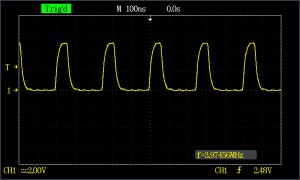Maximum frequency an Arduino can generate
What is the maximum frequency an Arduino can generate? Typically, I obtained a frequency of less than 100 kHz using the Arduino function calls. The results were lower than I expected. I also observed that I had a frequency higher by 25 kHz using a pin from the 8 to 13 pin set than a pin from the 0 to 7 pin set. These tests yield a virtually perfect waveform. I obtained almost 4 MHz by accessing the register directly. The waveform was not as good as the waveform of the first four tests. The waveform is given in Figure 1.
| Sketch 1 | Frequency: 72.6 kHz Duty Cycle: 47.7% |
#include
|
| Sketch 2 | Frequency: 74.3 kHz Duty Cycle: 49.2% |
#include |
| Sketch 3 | Frequency: 96.94 kHz Duty Cycle: 49% |
#include |
| Sketch 4 | Frequency: 96.94 kHz Duty Cycle: 49% |
#include |
| Sketch 5 | Frequency: 3.97 MHz Duty Cycle: 25.6% |
#include |
Click on the image to improve the quality.
